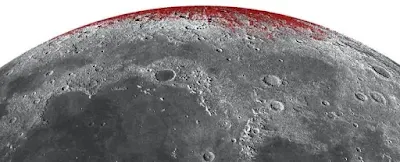Earth's normal satellite Moon may be rusting
WELCOME TO INDIAN SPACE NEWS
Earth's normal satellite Moon may be rusting
Information from the Indian Space Research Organization (ISRO) has uncovered that the Earth's normal satellite Moon may be rusting. The new examination recommends that the moon is turning somewhat red, demonstrating the arrangement of a rosy dark mineral type of iron named hematite on its surface, especially at the posts.
The development of rust or iron oxide can be ascribed to the nearness of two key components—water and oxygen—when they interact with iron. The moon surface is covered with iron-rich rocks, which may encourage this synthetic response when joined with the other two components. Notwithstanding, the Moon doesn't have any rich wellspring of water and is without oxygen in its climate.
"It's astounding," said Shuai Li from the University of Hawaii, who is the lead creator of the examination. "The Moon is an awful situation for hematite to frame in." So, what set off such a concoction response euphoric? Researchers state that the fundamental explanation for this change could be the Earth's climate.
Analysts saw this marvel on the Moon while inspecting information from the Moon Mineralogy Mapper (M3) instrument installed ISRO's Chandrayaan-1 rocket. The information got from the M3 uncovered the Moon's shaft had an alternate sythesis when contrasted with its surface.
Function of Earth's environment
For iron to change over into rust it needs oxidizers, which can take electrons from the iron and in this manner start rust arrangement. To comprehend the reason, the group inspected the barraging of hydrogen from the sunlight based breeze. Nonetheless, it had the contrary impact since hydrogen is a reducer—which gives electrons as opposed to taking it. Thusly, sun powered breezes may not be the purpose for rusting on the Moon's surface.
The airless Moon may need climate to help the development of oxygen, yet it has hints of oxygen that ventures out from Earth to arrive at the lunar condition. Along these lines, specialists state the Earth's magnetotail—an extended area of the planet's magnetosphere—assumes a huge function in this change saw delighted.
In 2007, Japan's Kaguya orbiter helped researchers find that oxygen from Earth's upper air can go through magnetotail to the Moon, which is 3,85,00 kilometers from the Earth. Consequently, the earthbound oxygen can arrive at the close to side of the Moon confronting the Earth and this discovering implies that the oxygen from Earth might be driving the arrangement of hematite on the lunar surface.
What's more, the magnetotail meddles with the hydrogen atoms delivered from the sunlight based breeze to arrive at the Moon climate, which whenever came to may repress this rust development. According to the announcement from NASA, the magnetotail hinders about 99% of the sunlight based breezes during specific periods of the Moon's circle—explicitly in the full Moon stage.
According to NASA, the Moon is gradually moving ceaselessly from the Earth for billions of years and getting an inch farther consistently. "Thus, it's likewise conceivable that more oxygen jumped over this break when the two were nearer in the antiquated past," included the announcement.
Missing hints: nearness of water on Moon
At this point, researchers had the option to interpret the nearness of oxygen, iron for the rust arrangement. However, one most significant component to convey this response was all the while missing i.e., water.
That is the place the information from Chandrayaan 1 again becomes an integral factor. Scientists utilized the information got by the Indian space office's lady Moon crucial—stayed practical till August 28, 2009. The strategic credited with finding hints of water ice on the posts of the Moon alongside outlining various kinds of minerals shaped on the lunar surface.
Scientists broadly considered the information acquired from the Moon Mineralogy Mapper instrument locally available rocket. The nearness of water has been just recognized on the posts of the lunar surface as solidified water, which remains primarily in shadow.
In any case, this examination zeroed in on the water discovered in any case in the lunar surface rather than just on the posts as the hematite was found a long way from this solidified ice. Responding to this perplexing inquiry, researchers suggest that quick moving residue particles may start the arrival of surface borne water atoms, accordingly permitting water to blend in with iron.
"Warmth from these effects could expand the oxidation rate; the residue particles themselves may likewise be conveying water atoms, embedding them into the surface so they blend in with iron. During the perfect minutes specifically, when the Moon is protected from the sun oriented breeze and oxygen is available a rust-actuating concoction response could happen." clarifies the announcement from NASA.
The examination was distributed in the diary Science Advances this week and can be gotten to here. The group of specialists behind the examination contained researchers from the California Institute of Technology, University of California at Berkeley and other rumored foundations in the USA.




Comments